Trees Birds Mammals Fish Amphibians Reptiles
Wild Algarve
Bookshop
Psathyrella candolleana (Fr.) G. Bertrand - Pale Brittlestem
Phylum: Basidiomycota - Class: Agaricomycetes - Order: Agaricales - Family: Psathyrellaceae
Distribution - Taxonomic History - Etymology - Identification - Culinary Notes - Reference Sources
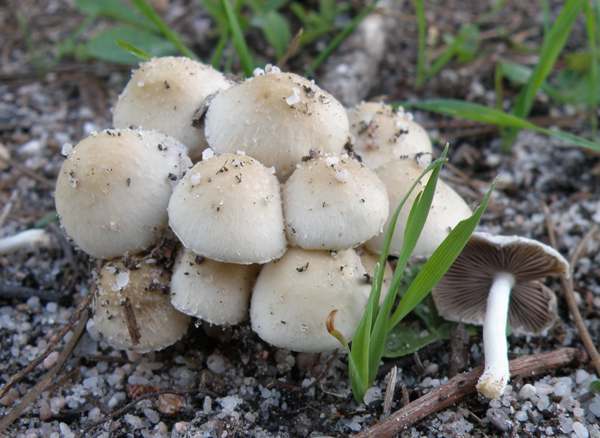
In the past more commonly referred to as the Common Crumblecap, Psathyrella candolleana is a very delicate member of the inkcap-related group of fungi. This mushroom occurs in all kinds of woodlands and woodland clearings as well as on timber buried in damp grassland.
The specific epithet is nothing to do with candles; it is in honour of the Swiss botanist Augustin Pyramus de Candolle (1778-1841). His botanical author abbreviation is DC.
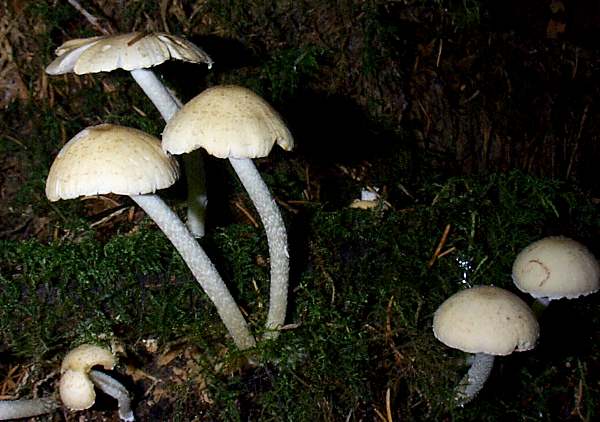
Distribution
Common and widespread in meadows, on lawns and in woodlands throughout Britain and Ireland, the Pale Brittlestem is also found throughout the European mainland and in many other countries including North America.
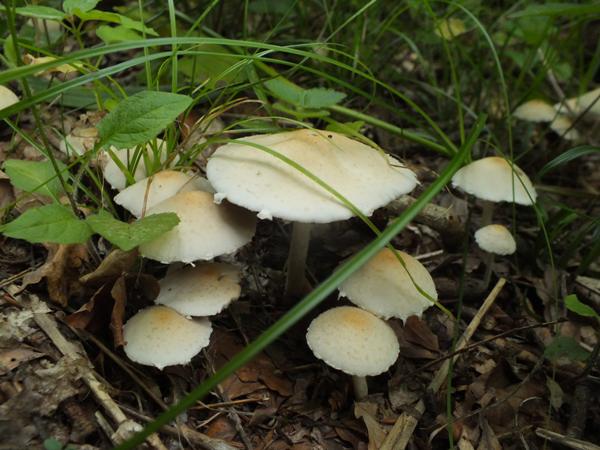
Taxonomic history
The basionym of this species dates from 1818, when the great Swedish mycologist Elias Magnus Fries described the Pale Brittlestem, giving it the binomial scientific name Agaricus candolleanus. (French mycologist Jean Baptiste Francois (Pierre) Bulliard had described this mushroom nearly thirty years earlier, calling it Agaricus appendiculatus; however, the specific epithet appendiculatus had already been used and so under ICBN rules for botanical/mycological binomial names Fries' epithet takes precedence.) The currently-accepted scientific name Psathyrella candolleana dates from a 1913 publication by French mycologist G. Bertrand. (Currently we have no biographical information about Bertrand other than a publication date.)
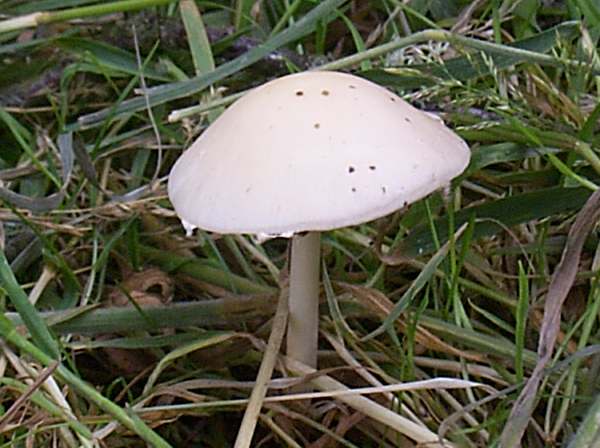
Over the past 230 years Psathyrella candolleana has acquired numerous synonyms including Agaricus appendiculatus Bull., Agaricus candolleanus Fr., Psathyrella corrugis var. vinosa (Corda) Cooke, Drosophila candolleana (Fr.) Quél., Hypholoma felinum (Pass.) Sacc., Psathyrella appendiculata (Bull.) Maire, Psathyrella egenula (Berk. & Broome) M.M. Moser, Hypholoma incertum Peck, and Psathyrella microlepidota P.D. Orton.
Etymology
Psathyrella, the genus name, is the diminutive form of Psathyra, which comes from the Greek word psathuros meaning friable; it is a reference to the crumbly nature of the caps, gills and stems of mushrooms in this genus. The specific epithet candolleana honours Swiss botanist Augustin Pyramus de Candolle.
Identification guide
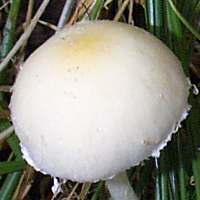 |
Cap
The cap is thin-fleshed and very crumbly;
typically 3 to 6cm in diameter and usually broadly umbonate when fully expanded. Cap colour varies considerably, but is usually brownish when young and fresh becoming much paler at maturity. |
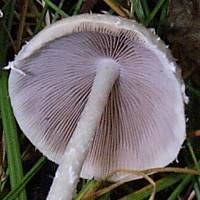 |
Gills
The gills are adnexed, crowded and initially
white, becoming pinky-grey and eventually very dark brown as the spores
mature.
These fungi do not deliquesce (dissolve) at maturity.
Stem
Up to 6cm tall, with a diameter of 3 to 5
mm; white and very brittle. |
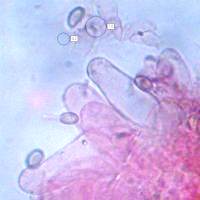 |
Cheilocystidia
Thin-walled; shape rather variable, but mostly sub-utriform or clavate, up to 50μm tall and typically 12μm across at widest point.
Spore print |
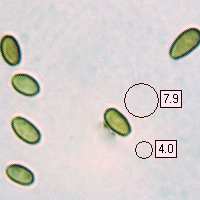 |
Spores
Ellipsoidal, smooth, 6.5-9.5 x 4-5μm; with a germ pore.
Spore print
Dark brown. |
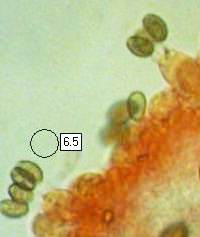 |
Basidia
Four-spored |
Odour/taste |
Not distinctive. |
Habitat & Ecological role |
Saprobic, appearing in small groups or occasionally
singly on soil in woodland or in well-shaded grassland. |
Season |
June to November in Britain and Ireland. |
Similar species |
Psathyrella piluliformis has a darker cap, is smaller and usually grows in much larger
groups; it is almost invariably on or beside broadleaf tree stumps. |
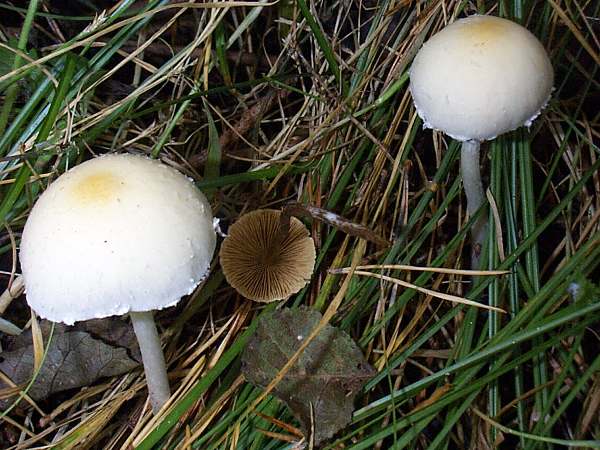
Culinary Notes
In many (but not all) field guides Psathyrella candolleana is recorded as 'edible but not worthwhile', while other field guides record it as inedible or edibility unknown. These mushrooms are insubstantial and it would take a lot of them to make a meal, so unless you are desperate and nothing else is available the Pale Brittlestem is probably not worth considering as a culinary collectible.
Reference Sources
Fascinated by Fungi, 2nd Edition, Pat O'Reilly 2016, reprinted by Coch-y-bonddu Books in 2022.
Bertrand, G. (1913). Quelques notes sur les Psathyra et les Psathyrella récoltés en Lorraine. Bulletin Trimestriel de la Société Mycologique de France 29: 185-188, tab. 8.
Funga Nordica: 2nd edition 2012. Edited by Knudsen, H. & Vesterholt, J. ISBN 9788798396130
BMS List of English Names for Fungi
Dictionary of the Fungi; Paul M. Kirk, Paul F. Cannon, David W. Minter and J. A. Stalpers; CABI, 2008
Taxonomic history and synonym information on these pages is drawn from many sources but in particular from the British Mycological Society's GB Checklist of Fungi.
Top of page...
Fascinated by Fungi. Back by popular demand, Pat O'Reilly's best-selling 450-page hardback book is available now. The latest second edition was republished with a sparkling new cover design in September 2022 by Coch-y-Bonddu Books. Full details and copies are available from the publisher's online bookshop...